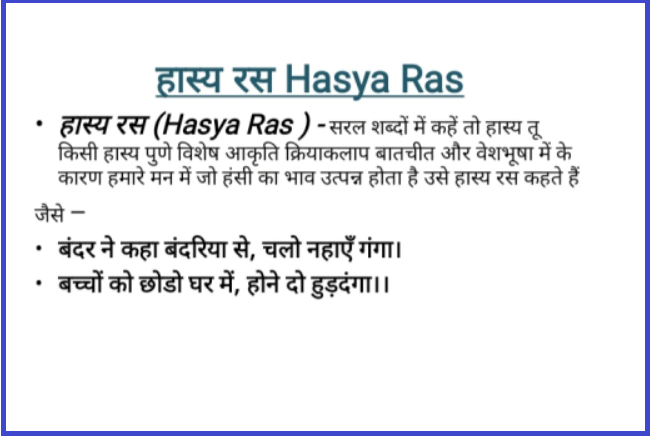Exploring the Essence of Hasya Ras: A Journey Through Humor in Indian Literature

Welcome to our exploration of “Hasya Ras,” a significant concept in Indian aesthetics, particularly in literature and performing arts. Hasya Ras, or the essence of humor, plays a pivotal role in adding vibrancy and relatability to various art forms. In this comprehensive guide, we delve into the world of Hasya Ras, offering examples and insights that bring this concept to life.
Also Read:- Months Name In Hindi And English
Understanding Hasya Ras: Hasya Ras, in Indian aesthetics, refers to the sentiment of humor. It’s one of the nine Rasas (emotions) that classical Indian arts revolve around. This Rasa is all about evoking laughter and amusement, often through witty dialogues, comical situations, or humorous characters. It’s a way to create a light-hearted and joyful atmosphere in literature, drama, and poetry.
Examples of Hasya Ras:
- Classic Literature: The works of the legendary poet Tenali Raman are quintessential examples of Hasya Ras. His stories, filled with wit and humor, not only entertain but also impart moral lessons.
- Folk Tales: Indian folk tales, especially those involving characters like Birbal and Gopal Bhar, are replete with instances of Hasya Ras. Their clever solutions to tricky problems often bring a smile to the reader’s face.
- Modern Literature: Contemporary Indian literature, including works by authors like Khushwant Singh, often weave Hasya Ras into their narratives to add a layer of entertainment and social commentary.
Hasya Ras in Performing Arts: In performing arts, Hasya Ras is predominantly seen in stand-up comedy, comedic plays, and certain types of classical dances where comic interludes are a part. These performances use humor as a tool to engage the audience, often highlighting societal issues in a light-hearted manner.
Impact of Hasya Ras: Hasya Ras is more than just entertainment. It’s a powerful medium to convey messages, critique societal norms, and offer a different perspective on life’s complexities. It also serves as a stress reliever and a means to create a bond among audiences.
Conclusion: Hasya Ras is a vital element in Indian literature and performing arts, offering a unique blend of humor and wisdom. It not only entertains but also enlightens, making it a cherished aspect of Indian culture.
Short Answers:
- Karun Ras Ka Udaharan:
Karun Ras, the essence of sorrow and compassion, is vividly portrayed in Kalidasa’s “Abhijnanashakuntalam,” where the separation of Shakuntala and King Dushyanta evokes deep emotional pain and empathy. - Hasya Ras Ki Paribhasha:
Hasya Ras is defined as the sentiment of humor in Indian aesthetics, characterized by its ability to evoke laughter and amusement through witty dialogues, humorous characters, and comical situations. - Hasya Ras Ki Paribhasha Udaharan Sahit:
Hasya Ras, the sentiment of humor, is exemplified in the witty exchanges between Birbal and Emperor Akbar, where Birbal’s clever responses not only amuse but also subtly impart wisdom. - Karun Ras Ki Paribhasha:
Karun Ras is the sentiment of sorrow and compassion in Indian aesthetics, often portrayed through narratives that depict pain, loss, or tragedy, evoking a deep sense of empathy in the audience.
FAQs:
- What is Hasya Ras?
Hasya Ras is the sentiment of humor in Indian aesthetics, focusing on creating laughter and joy. - Can Hasya Ras be found in modern literature?
Yes, contemporary Indian literature often incorporates Hasya Ras, blending humor with social commentary. - How does Hasya Ras impact society?
Hasya Ras not only entertains but also offers insights into societal norms and serves as a stress reliever. - Is Hasya Ras relevant in performing arts?
Absolutely, Hasya Ras plays a significant role in stand-up comedy, comedic plays, and certain classical dances. - Can Hasya Ras convey serious messages?
Yes, while primarily humorous, Hasya Ras can be used to subtly convey important messages and critiques.








